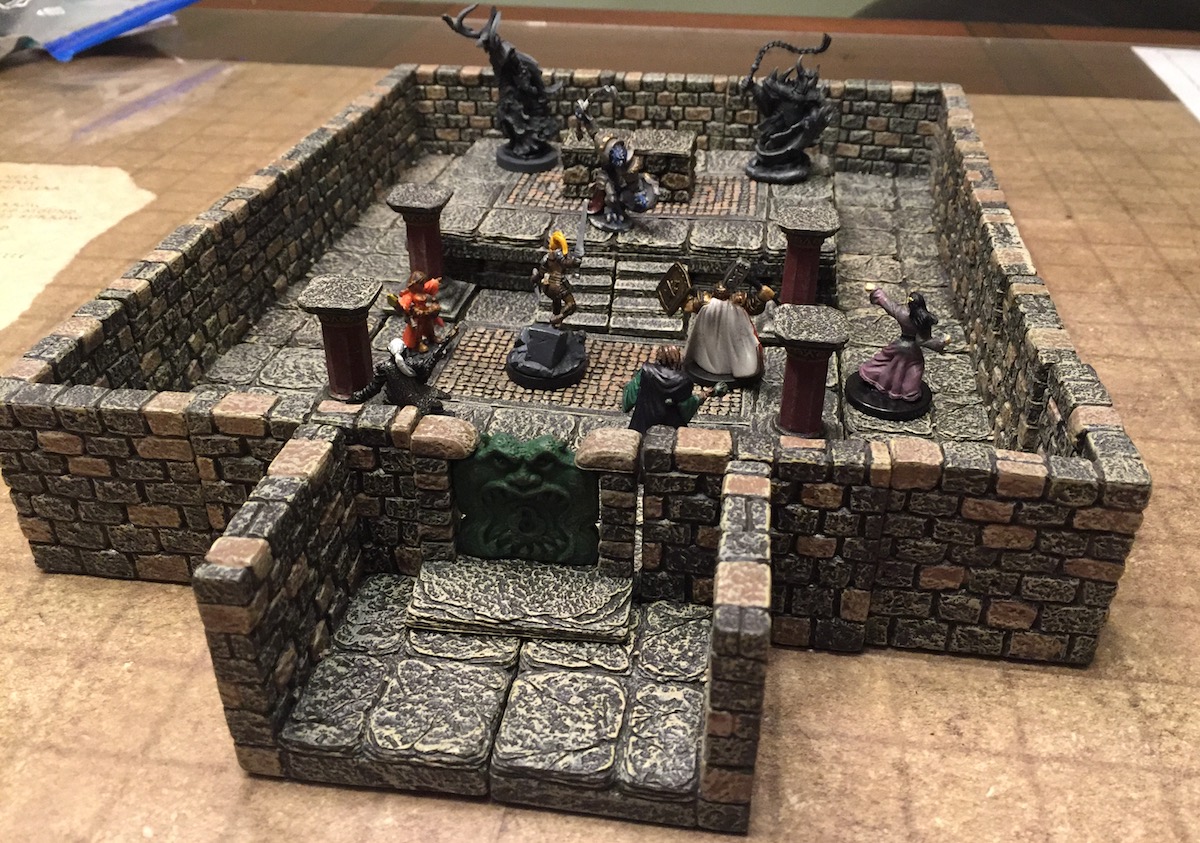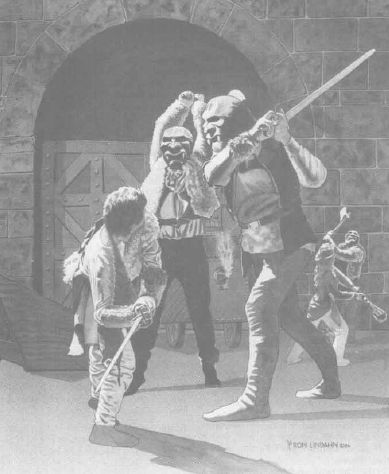
Lenard Lakofka


I have designed many complex melee combat
systems that have
included such items as “hit location” and
even “special damage.”
These systems have met with good reception
by players, who have
found them realistic, exciting and time
consuming. Alas, the time taken
when a figure has a good armor class, many
hit points and/or many
henchmen makes the system very time-consuming!
Thus I have decided that the simpler combat
system, as espoused
by Gary Gygax, is probably better in the
long run. However, there are
items in the AD&D
basic melee system that I
do not like. Therefore I have come up with
the following “Segment of
Action” system that has the advantages
of versatility and the potential
for complexity (if the Dungeon Master really
likes to include weapon
length and speed factors into a melee).
I will take the system in stages from basic
hand-to-hand combat, to
spell casting, miscellaneous actions, movement
and special treatments.
I. The basic hand-to-hand
melee system in which figures
are fighting with weapons (natural or
otherwise) that have the
same basic length and spell factors
is as follows:
(Charges and
multiple blows in the melee round will
not be considered at this time.
Note: Length and speed factors are not
inherent in the system but can
be handled by it, as seen later.)
Roll d10 and d20 for each figure. The first
die measures “initiative”
and the second measures the normal chance
“to hit.” (Note: This use
of the word “initiative” does not equate
with the AD&D use of the
word.)
The d10 tells when in the melee round the
event, in this case the
blow with the weapon, will occur. Thus
if a 7 is rolled the weapon will
be used in the seventh melee segment. The
d20 gives the chance “to
hit” in the normal manner.
I do not wish to enter, for a lengthy period,
the subject of why a
figure only gets one blow. Remember the
melee is NOT static and that
movement, distance, and range in AD&D
is NOT meant to be scaled to
“real life.” Thus, a figure gets his/her/its
one blow per round with a
weapon, and the Segment of Action system
tells you when that blow
will be dealt If you and your players decide
that you want “real life,”
divide all spell-casting times by 6, multiply
ranges by 6, multiply movement
by 6, reduce melee to 10-second periods,
etc. If ONE portion is
tampered with, everything involving range,
distance, and time MUST
change. This radical change is just not
worth it. After all, it is only a
game.
By knowing when the weapon will be used,
it is a simple manner to
add other factors at a later time. Note
that dexterity does NOT alter this
roll in any way (though you may want it
do). Dexterity is taken into
account in defensive armor class and when
surprise is measured.
For example, a hobgoblin
with AC 5 and a long sword is
fighting a warrior with armor class 7 who
also has a long sword.
Warrior rolls 7/17 (meaning d10 = 7 and
d20 = 17).
Hobgoblin rolls 3/5.
The Hobgoblin has the chance to strike
first (segment #3) but
misses with a roll of 5 “to hit.” The warrior
does not get a chance to
strike until segment 7 but then succeeds
with a 17.
If the Hobgoblin is not killed, melee continues.
Warrior rolls 5/18.
Hobgoblin rolls 5/20.
Simultaneous blows, and both hit! Again
let us say neither is slain.
Warrior rolls 4/18.
Hobgoblin rolls 7/16.
The Warrior goes first and hits. If he kills
the Hobgoblin, the melee is
over since the Hobgoblin’s chance to hit
does not come until the 7th
segment.
Option: If a figure is killed, he/she/it
will still get his/her/its blow as
long as he/she/it strikes simultaneously.
If “initiative” is off by 2 or more
segments the blow is always lost. However,
if the blow is only 1
segment late the dying (unconscious) figure
still is allowed a blow if the
dying figure makes a normal saving throw
versus death. Obviously this
option does not apply if the weapon (action)
paralyzes, disintegrates or
somehow destroys free action.

II. Figures with multiple
attacks or with multiple blows per round:
If a fighter has two blows per melee round,
d10 is not used for
initiative, 2d6 are used instead. The first
d6 gives the segment of the first
blow, the second d6 added to it gives the
time of the second blow. If the
sum of the two is 11 or 12, then the last
blow is still awarded but it is the
last action of the round. If three blows
are allowed, use 3d4 for the first,
second and third blows. Different-colored
dice are recommended.
If a monster has multiple attacks (e.g.
claw, claw, bite), initiative can
be measured in two different ways. I suggest
only one die for all three
attacks if they are all against one opponent.
If against more than one
opponent, then use a separate d10 for each
opponent. If a monster
charges with two horns, even if there are
two opponents, I’d use just
one d10.
Monsters with more than three attacks per
melee round, even if
versus the same opponent, should likely
be measured by multiple d10,
e.g. a Demon
Type V gains 7 attacks. Using only one d10 is likely not
best, but 7d10 is difficult. Compromise
on 3d10, the first roll for 3 arms,
the second for 3 more and the last for
the tail. Obviously, you can rule
on this any way that is most playable.
III. Missile fire:
Missile fire does not use d10 if a figure
has multiple missile capacity
per round. Thus, if an archer is allowed
two arrows per melee round
2d6 would be used. If the archer is ready
and “guarding” you might
allow d4 for the first arrow and d6 for
the second. Even if the total of the
2d6 is 11 or 12, the second arrow is allowed
unless the archer is
hit/killed. An archer who takes damage
from a missile (or spell or blow,
for that matter) should lose some initiative
when firing. An addition of
1-4 to the second d6 is a reasonable penalty
and can be a function of
actual damage taken. Remember that archers
hit by a fire ball, e.g., will
not have any bowstrings left, to say nothing
of bows and arrows.
Missiles fired simultaneously, as in a
Manticore
blast, used d6 for
the segment of fire and not d10. Firing
missiles is usually faster than
jockeying for position to strike a blow
with a hand-held weapon. Thus,
d6 or even d4 is used for missiles with
only a single firing per round, like
a spear, throwing ax, dagger, sling bullet,
etc. This assumes the figure is
not surprised and has weapon and ammunition
at hand!
If a figure is charging and throwing a
missile and then closing for
melee (or if he fires and is then closed
with by an opponent) the missile
is measured by d4, and the segments needed
to move the required
distance are calculated. Another d4 (or
perhaps d6 or even d8 for a
large, heavy weapon) is rolled for the weapon
action. If this roll plus the
first roll and the movement come out to
10 or less, he can strike with the
weapon; if 11 or higher is rolled either
the weapon action is prohibited
or comes last in any event.
For example, a fighter has a spear and
a short sword. He wishes to
throw the spear and then cross “three inches”
to melee an opponent.
Roll d4 for the spear, add ‘3’ for the
movement, then since the weapon
is small (sword) and light he can draw
it and still strike (roll another d4)
in the same round after the movement.
However, if an archer wishes to fire an
arrow, drop his bow, cross
“five inches” and then attack with a two-handed
sword, it is another
matter. Roll d4 for the arrow (let’s say
a 3), then add ‘5’ for the
movement, which means it is the 8th segment
when the man arrives at
his opponent’s location. For the weapon
I’d use d8 since it is heavy and
awkward. If 1 or 2 comes up, the blow is
allowed since it will fall in the
9th or 10th segment of this round. But
if 11 to 16 comes up the blow
should be disallowed altogether, i.e.,
the fellow got there but the
weapon was not in place for a blow.
Most “double actions” can be measured in
this way. It is common
for a figure to discharge something (even
a spell), move, and still want
to fight. Such actions are surely not unreasonable
but are impossible
unless some way to measure the segment(s)
of action is possible. This
system easily allows for such multiple
actions by choreographing the
round and deciding when each action occurs.
A figure should NEVER
be allowed two actions in one segment (even
though we as real people
could do more than one action in one segment)
as that is grossly unfair
within the rules of the game.
IV. Spell Casting:
Spell casting
is measured from a base of d4. This will give the
segment in which the spell begins. Remember
that spell-casting time
must also be added in! Thus, if a 1 is
rolled on d4 the spell caster begins
his/her casting in segment #1 and finishes
as many segments later as
the spell-casting time dictates. If he/she
is hit during the casting, the spell
is ruined and useless. If he/she is hit
before the spell casting begins,
he/she, if not killed or immobilized, might
still be able to cast the spell.
You might wish to throw for “surprise”
in such a case using d6. A roll of
4 to 6 means no “surprise” and the figure
may cast his/her spell, but a
roll of 1-3 is added directly to casting
time as a delay due to the effects of
the hit. (Note: A spell caster who is missed
or who makes his/her saving
throw and thus takes NO damage will not
be delayed in his/ her spell.) It
vis essential that the DM realize that
material components must be “at
hand” before d4 can be used for spell initiative.
If they must be gotten
out then d6, d8, d10 or worse might be
in order! Also, d4 assumes no
“surprise.”
In a melee situation it is unlikely that
any spell can succeed, but the
DM might allow quick l- or 2-segment spells
to be attempted. Longer
spells will require relative immobility,
which will decrease armor class
by at least 4 levels. Thus, while Shield
or Magic Missile might be tried a
longer spell would surely be spoiled by
the mere fact that the opponent
is right on top of the spell caster and
can grapple or just push him/her if
not hit him/her with a weapon.
Breath and Glance Weapons could use d4,
as they are very rapid.
However, the slow movement of the catablepas,
for example, might
allow up to d10.
Finally, in the discussion of missiles,
spells, breath and glance
weapons comes ranges and time. An arrow/sling
bullet might take a
segment or two to travel to its target,
perhaps 1 segment consumed per
6” of flight. Breath and glance weapons
consume no time in this respect
so the breath would reach its full proportions
within the first segment.
Spells that fire a projectile might be
considered as rapid arrows while
those that produce an effect would be instantaneous.
Thus Lightning
Bolt and Earthquake are instantaneous but
Magic Missile might consume
1 segment per 12” traveled, just as Fire
Ball might take some time
to travel. The DM must rule and think out
this situation for him/herself
before play begins.
V. Magic items:
Magic item
discharge can fit into this system too. Most items have a
casting time explained in the text of the
item in the DM Guide. Add to
this d4 or some other appropriate die to
simulate getting the item out
and ready for use. Items can be used in
melee and are often not foiled
by grappling or even a strike “to hit,”
since concentration is not always
broken by a physical action. Decisions
on this must be made on an
item-by-item basis. E.g., a wand in a belt
would be ready in 1-4
segments, or a Golden Lion can be taken
from a pocket and cast down
in 1-4 segments. But if the Lion is in
a backpack, as many as 12
segments could be used in finding the device
before casting it down.
The Lion might still take some segments
to grow.
Surprise
is still used in melee, of course. It is usually d6 for the party
and d6 for the monster. I suggest using
d6 per character and not for the
group. This is not feasible if the melee
is too large, of course. Dexterity
applies to surprise. I might add that the
example in the Players Guide
and repeated in the DM Guide does not seem
to be correct. I and the
other proofreaders did not catch the mistake
and omission in the list
given in the example.
When measuring surprise, be sure that nomenclature
is the same to
avoid confusion. Thus, measure the chance
“to surprise”, or the
chance “to be surprised” for each figure;
do not measure the party’s
chance to surprise a monster but the monster’s
chance to be surprised.
You will go nuts. Sometimes this means
changing the numbers given
about a monster/race so that both sides
are measuring the same thing.
Surprise often applies only to a figure(s)
who can see an oncoming
problem, and thus the entire party can
not throw for the result. If the
reaction is to an area effect or a loud
noise, then the entire party can be
diced for. Remember that surprise does
not always apply to a situation
or even to both sides in a situation. There
is no real surprise if the sides
see each other at 200 feet. There may be
surprise if one side is seen
while the other is hidden. Once surprise,
if any, is determined, and the
number of free segments, if any, is measured,
melee goes on as
outlined herein.
At first it may seem that the separate initiative
on a character-bycharacter
basis is very time-consuming, but it plays
rapidly if both
“initiative” and “to hit” are diced at
the same time.
As new situations occur, the Segment of
Action System can easiy
be molded to cover them. The Dungeon Master
makes a decision as to
which die size should be used to determine
the segment of action and
then lets the player cast that die/dice
for the action (or he casts the
die/dice as necessary to maintain secrecy).
Weapon speed factors, of course, can be
added. Weapons of speed
1-3, e.g., add no time to melee; those
of factor 4-6 add 1 segment; 7-9,
2 segments; and 10+, 3 segments. Naturally,
you can refine even those
numbers if you wish, but I can not recommend
this, as it will produce an
unplayable result.
Weapon length can be considered, especially
in a charge or climbing
situation, by dispensing with the initiative
die when weapons are set
to repel.
The system will clearly tell you when an
event occurs in a complex
melee. Thus, if fighters A, B & C battle
Giant X, but Orc Y and Orc Z are
attacking A and B respectively, the situation
would normally be difficult.
In this system, roll d10 for initiative
for A, B & C obtaining 3,5,&
9. The Giant rolls 4, the Orcs 7 and 4
respectively. Therefore the attack
order is: A (with a 3); the giant and last
orc (with 4s) (if either attack kills
a fighter yet to attack the giant, that
fighter loses his blow); next fighter B
(with a 5); orc Y (with a 7) and Fighter
C is last with a 9. The order is
clear and the battle can be resolved in
order.
You will note the system allows for the
question of whether a figure
can get out of melee before a blow is struck
at him/her. If the figure who
is fleeing can beat the initiative of his
attacker (and assuming there is
someone to take his place), he can escape
jeopardy. The attacker can
still attack the new replacement, of course,
if the other figure has fled his
grasp!
The Segment of Action System is very flexible.
It allows for normal
situations but also allows the DM to provide
for new actions easily. The
old system of one side first, then the
other side is rather unfair and not
any easier once the mechanics here are
grasped. For huge battles I
would recommend a set of miniatures rules
and not individual melees
in any case.
I may well have missed some detail but
the skeleton of the system
has been used by my players for over two
years with good results.